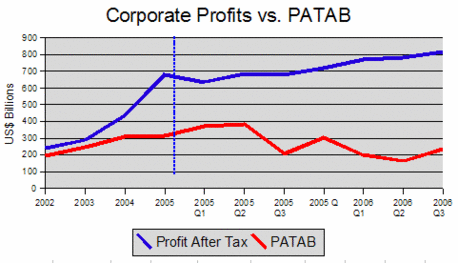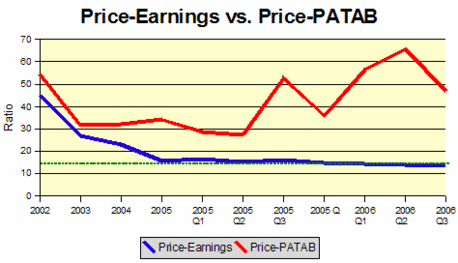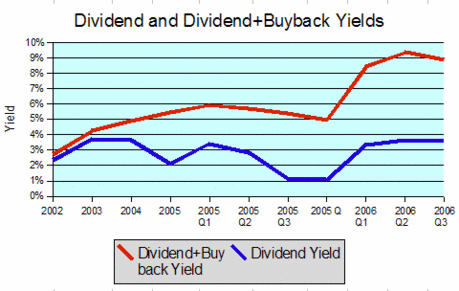Depending upon your point of view, the US stock market is either vastly over-priced, or a great bargain — and if you have a split personality, you could both be right!
This peculiar state of affairs occurs because two radically different yardsticks can be applied in measuring corporate performance: one based on an unquestioning respect for Generally Accepted Accounting Principles, and the other based on commonsense, an appreciation for cash in hand, and the time-honored principle of “what’s in it for me?”.
The key to this conundrum lies in how one views stock buybacks: Are the trillions spent on buybacks really the money of most common shareholders, or do they belong to someone else?
- If you are a long-term, buy-and-hold investor, with a portfolio made up mainly of index funds and equity mutual funds, the money that goes into stock buybacks is definitely not yours. It goes to someone else. You’ll never see a penny of it!
- If, however, you are a corporate executive with loads of stock options, or with remuneration linked to stock prices, or if you are an equity hedge-fund manager, with 20% of the profits on borrowed money and somebody else’s nickel, with no downside risk (for you), then stock buybacks are definitely to your advantage.
If you believe that GAAP profits tell the whole story, then perhaps equities are really a bargain. Don’t worry, be happy.
However, if you’re a tiny bit skeptical and are willing to look at profits with a reasonable, “what’s in it for me” philosophy, then you might start running for the hills.
Learn to Think PATAB!
You’ve probably never heard of PATAB, and that’s because it’s a term I just created. It means: profits-after-taxes-and-buybacks, as distinguished from ordinary profit-after-taxes.
This graph, using data from Federal Reserve flow of funds account F102, shows the difference between ordinary after-tax accounting profits, and PATAB:
|
|
|
|
Corporate profits, adjusted for buybacks
|
|
|
|
|
Ordinary after-tax corporate profits, more than tripled between 2002 and Q3 2006, which suggests that everything you’ve read in the Wall Street Journal about this being ‘the best of times’ seems to be true.
However, PATAB earnings failed to recover from the doldrums of the 2000 market crash and show stagnant corporate earnings.
A Look at Price-Earnings Ratios
Another measure of equity value is the price-earnings ratio.
Using Federal Reserve flow of fund data from tables F102 and L202 (total after-tax profits and the market value of non-farm, non-financial corporate business) we see that rising accounting profits caused price-earning ratios to drop from over 40 times earnings (in the post 2000 crash years), leveling off at around fifteen times earnings — ordinarily a sign of a fairly-priced market.
|
|
|
|
Price-earnings ratios: with and without buybacks
|
|
|
|
|
However, the Price-PATAB ratio is something else again, by mid 2006 rising to levels of 50 and 60 times earnings after taxes and buybacks.
If you’re not getting any of this buyback money (you would have to have sold stocks at a handsome profit to qualify) stocks are definitely over-priced for you.
Dividend Yields and PATAB
Finally, we may also examine dividend yields, taking buybacks into consideration. If you believe that buybacks are just another form of dividends, then ‘dividend yields’ on commons stocks over the last few years have been extraordinary — rising to 9% by Q3 2006!
With such handsome yields, and price-earnings ratios hovering around fifteen, and with dramatic growth in corporate earnings — surely stocks must be fairly priced!
|
|
|
|
If buybacks were really dividends ...
|
|
|
|
|
But, if you’re not in on the buyback bonanza (i.e., if you’re holding stocks ‘for the long run’), then you’ll want to look at corporate results from a PATAB viewpoint. This shows corporate earnings flat, stocks prices over 50 times PATAB earnings, and meagre cash dividend yields of around 3% — definitely a description of an over-priced market.
Think of Buybacks as a Special Preferred Dividend
If buyback money was being paid to a special kind of preferred shares, rather than being used to repurchase common stock, audited financial statements would routinely show common stock corporate earnings in terms of profits after taxes and payments to preferred stockholders.
However, buybacks fall into a blind space in Generally Accepted Accounting Principles, and are treated neither as an expense, nor as profits paid to another class of shares. The reason for this is that buyback benefits are not a contractual right of a certain class of shareholders, but only a benefice, paid out at the discretion of company directors.
Security analysts who follow the Graham and Dodd philosophy, do not take GAAP profits as the Word from the Almighty, but rather as a starting point for logical adjustments necessary in interpreting investments for particular classes of investors.
Stock buybacks are like a ‘preferred dividend’ to executives who hold stock options at no cost and who give value to their own options by using buybacks to manipulate stock prices upwards, exercising these options, with no risk. The ordinary shareholder, in contrast, can only get some of this buyback money by selling stock that was paid for in hard cash and held at risk.
Generally Accepted Accounting Principles (like most rules) were written in the context of expected corporate behavior — many years ago — but times have changed and what was once considered normal behavior is now no longer the case.
The moment a rule is published, smart people find ways it may be bent to their advantage. In this, they are usually successful, forming coalitions of defenders of rules they believe to be beneficial — usually in ways never intended by the rule makers.
The Great Buyback Loophole
A problem arises in today’s equity markets because corporate stock buybacks total over one trillion dollars every two years, while the rules that deal with the accounting for stock buybacks date back more than a quarter century, when the practice was of minor importance and relatively rare.
Little serious thought has been given to reexamining methods of accounting for stock repurchases in the light of today’s practices.
Now those who place their hands on Generally Accepted Accounting Principles, as if they were a Holy Book, and swear that the method of accounting for stock buybacks is fair and in the best interest of all shareholders, would seem to be on the side of the angels.
But, as Shakespeare noted, “Even the devil can quote scripture.” To many people, the argument that buybacks are accounted for according to GAAP rules is the end of the matter — a signal to turn off their brains and turn on their TV sets. It’s in the Holy Book of GAAP! Why think about it any more?
And indeed, it is difficult to dismiss the rules and think about what really might be a proper way to account for stock buybacks. It’s much, much easier to dismiss the matter as already settled.
But it would be a worthwhile endeavor, because the Great Buyback Loophole is the rule that governs today’s stock markets.
Profits in the Eye of the Beholder
Reports produced by accountants are supposed to provide useful information to various stakeholders in the enterprise.
For example, a report showing EBITDA is of particular interest to bondholders, seeking to evaluate a company’s capacity to cover interest due on bonds they own.
Today’s accounting reports for corporate stockholders routinely show earnings after taxes, adjusted for payments to preferred shareholders that have a prior claim on earnings.
When Wall Street crows about great corporate earnings, they are usually talking about after-tax earnings available to common stockholders.
It all seems so straightforward — the Word According to GAAP — until we try to deal with massive stock buybacks that dominate the US equity markets today.
The Case of Common A and Common B
You will note that accounting reports generally are bound by the legal rights of various stakeholders in an enterprise — not by customary behavior of directors acting under their discretionary powers.
Corporate director have powers to use corporate assets in ways that often are not in the interests of common shareholders, including their right to determine the remuneration of executives and to approve poorly conceived acquisitions and mergers.
Many decisions of directors have a direct bearing on the amount of profits available to common stockholders, but, according to accounting rules, will not be accurately reflected in reported earnings — a case in point being stock buybacks.
Consider the following situation:
Corporation XYZ has two classes of shares: Common A, that account for 5% of the capital, and Common B, that make up the rest. The by-laws state that dividends paid to Common A and Common B are at the discretion of the directors, and need not be the same.
Now, for over twenty years, Corporation XYZ has paid one thousand dollars per share to Common A shares and one dollar per share to Common B shares. In reporting profits to shareholders, however, the directors show the entire profits as belonging to all common shareholders, before dividends. The habits of the board in distributing these dividends according to the peculiar by-laws of Corporation XYZ are not considered relevant.
The price-earnings ratio for Corporation XYZ is calculated by stockbrokers and the financial press (who are friendly with the directors), are on the basis of earnings before dividends, as is customary. When these earnings increase, stock prices rise in line with the price-earnings ratio.
Is this correct and proper?
The directors of Corporation XYZ argue that dividends paid to Common A shares should not be deducted from reported earnings because:
- Common A has no legal right to any differential dividends from Common B;
- Dividends paid to Common A have exactly the same accounting treatment as dividends paid to Common B, and both are in accordance with GAAP;
- Maybe next year, the directors might decide to pay $100 per share to Common B and no dividends to Common A, in which case, to try to report profits “available to Common B” would be shown to make no sense.
Now maybe you have an easy answer for this case, because there are two classes of common shares. Or you may think that no stock exchange would list a company with such strange rules. However, the point being made is that accounting standards do not necessarily present information fairly to all shareholders.
Now, lets advance to a case with only one class of common shares.
The Case of the Foreign Investors
Country ABC has a law that requires foreign investors to get government approval before selling common shares of domestic corporations. This approval takes many months and usually is conditioned on paying a high excise tax and repatriating the proceeds of the sale. Consequently, foreign investors in Country ABC are generally long-term investors, looking mainly to dividends as a return on their investment.
Company XYZ in Country ABC is held one-third by domestic investors and two-thirds by foreign investors, with directors chosen by domestic investors. The directors, inspired by the behavior of directors in the US market, decide each year to declare large stock buybacks and, at the same time, offer all domestic shareholders options to buy an equivalent amount of stock as the amount repurchased at one-half the buyback price.
As a result of this policy, almost the entire profits of the company are used each year for stock buybacks. Domestic shareholders use options to acquire shares to sell into these buybacks, but foreign shareholders, because of government restrictions, can not take advantage of the buyback program.
Foreign shareholders in Company XYZ are required to declare earnings in foreign holdings, even undistributed, with certain tax consequences. The foreign shareholders in Company XYZ complain to their government that this is not fair, because these so-called “profits” are, in fact, used to pay for buybacks. Their government, however, is unsympathetic because, according the GAAP rules, funds used for buybacks are not an expense and should be included in profits.
So here we have a case in which GAAP rules are clearly misrepresenting the earnings of Company XYZ from the point of view of the foreign shareholders.
Most US Common Stock Investors Buy ‘em and Hold ‘em!
There are several things to note about the buyback movement and the behavior of US stockholders:
Most US investors buy and hold common stocks for long periods, selling only when they retire decades later. Stocks are often held in tax-deferred plans that impose penalties for cashing out too soon. A large portion of investor money is held in equity funds, which means, in essence, that investors are permanently in the stock market.
A minority of US investors have a stake in corporations, achieved not by holding common stock for which they paid in full, but rather as options, issued without cost, in virtue of their position. This class of common stock investors, in essence, holds shares at no-risk and receives ‘dividends’ of stock buybacks by exercising options for a assured profit.
Most US investor get investment advice from Wall Street brokers and fund management companies that have an interest in portraying common stocks in the best light. Generally Accepted Accounting Principles, by not requiring any special treatment of buybacks, allows Wall Street marketing people to mislead investors, with no fear of criticism from the SEC.
So, now you know. If you benefit from corporate profits as reflected in GAAP (that is, if you are a stockbroker, fund manager, or anyone whose remuneration to tied to accounting profits) then these are indeed the best of times.
However, if you are a modest, long-term investor, trusting implicitly in representations of Wall Street marketing men and women, and if you hold much of your retirement money in common stocks, then you have reason to be alarmed.
How To Create a Bonanza of Real Value for US Common Stockholders
You may have noticed from the above graphs that if Wall Street were to reform, demanding that the money now spent as buybacks be distributed, instead, as ordinary dividends, fairly and equitably to all shareholders, most investors would suddenly be justified in holding common stocks:
- Cash dividend yields would be over 9%, a premium over bond yields comparable to pre-1960 long-term averages.
- Price-earnings ratios would be about fifteen, in line with long-term consensus for a fairly-priced market.
- Corporate earnings would be increasing in line with inflation.
- Total cash return to long-term investors would be consistent with common expectations used in planning for retirement goals.
The chances of this happening are not great.
Common stock investors just don’t know what is going on and Wall Street is not about to tell them. So, in the meantime, unless you are lucky enough to be a beneficiary of the corporate handout, you might consider viewing claims of extraordinary good corporate results with a dose of skepticism.








